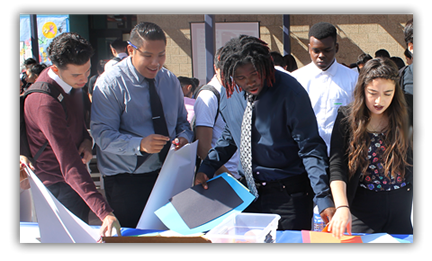What is CAP?
What is CAP?
CAP is a free project-based learning program for civics and government. Think of it as a culmination of students’ social studies education, a chance for them to apply what they have learned to the real world and impact an issue that matters to them.
From the CAP curriculum, you will first teach three lessons that are tied to government/civics content. These lessons provide content that students will need to start their own CAP projects. Once students start working on their own CAP issues, you will teach two more lessons that focus on policy analysis.
CAP provides a bundle of additional lessons for you to choose from, based on the needs and interests of your students.
Students could select issues related to school, community, or even national or global issues. CAP students identify an issue or problem that matters to them, connect it to public policy, then take “civic actions” to try to impact their selected issue/problem. It is up to you, the teacher, if you want to limit the scale of the issues they choose.
In any case, it is key that you require students to make the connection to public policy if you are integrating CAP into your government course.
- CAP is aligned to the Common Core State Standards for English Language Arts & History/Social Studies, Science, and Technical Subjects.
- CAP supports the C3 Framework’s four dimensions.
- CAP provides opportunities for young people to interact and make meaning of their civic experiences, supporting the three key factors for young adult success as outlined by the University of Chicago's Foundations for Young Adult Success report.
Getting Started with CAP
Register on the CAP website.
Teach the CAP lessons and assign the project.
Teach Lessons 1–3 to get your students ready to choose their issue and complete their CAP Proposal planners.
Teach Lessons 4 and 5 to prepare students to take civic actions and complete their Thinking It Through and Civic Action planners.
Supplemental Lessons are optional and anticipate topics that could help students as they work on their projects. These lessons include:
• Law & Policy
• Persuasive Speaking
• Building Constituencies
• Using the Media
Download Webinar Presentations
Webinar: The Project: Getting Your Students to Take Civic Action
Webinar: Showcasing Your Students Work: Culminating Activities and Assessment
What's the Fit? Tips from a Veteran CAP Teacher
Adapted from a workshop presentation by CAP teacher Patricia Vasquez, who teaches at Bell Gardens High School in Bell Gardens, CA.
FAQs
CAP defines civic actions as all of the things average citizens do to address a problem or issue in their community. Evidence may include notes and documents, photographs, and other tangible items related to what a student did. For example, if David goes to a public meeting, David may bring back a copy of the meeting’s agenda. If Susan interviews a public official, she may get a copy of the official’s business card. The CAP Planners themselves qualify as evidence of students’ civic actions. The Planners enable students to document civic actions they’ve completed, reflect on the results, and identify additional civic actions that they can take on.
An option for enrichment in CAP is provided in the Multimedia contest. The Contest provides cash awards for media products (e.g., a PSA or website) that captures your students CAP experience and promotes the importance of civic engagement. Rules and entry deadlines can be found on the Contest page of the CAP website.
All of these student-grouping models work with CAP. Here are some illustrations for each:
Small Groups. The class is divided into groups of 2–6 students, and each group selects its own issue or problem to work on.
-
- Some teachers have the class come up with a list of issues or problems, and students select one or two that interest them. The teacher then eliminates any issues that just get one vote. Students are grouped according to like-mindedness. This way, each student is working with at least one other student on an issue of interest.
- Other teachers put students in groups (or have students self-select partners) and let the groups come to agreement on their issue.
Whole Class. In this model, the teacher helps students reach consensus on a single problem or issue. Focusing on this one issue, students form separate groups that each address the problem in a different way.
-
- In a whole-class model, some teachers impose a structure by having all groups share the actions they are considering with the other groups in order to coordinate activities and use each other as resources. Each group can benefit from the feedback of other groups. A group may decide to change actions to avoid duplicate efforts, or after discussion, it may decide that duplicate efforts might actually strengthen the impact.
- Some teachers use the whole-group model to have their students apply concepts of self-governance. Students decide what needs to be done regarding the civic action forms and divide responsibilities accordingly.
Independent Work. Individual students may be passionate about a particular issue not selected by any of their peers and could work independently on their own CAP. Teachers might choose to assign CAP in lieu of a typical research paper, wanting each student to do CAP individually.
-
- You can choose to have regular deadlines when civic action forms from every student are due.
- Or you can maintain a bulletin board or inbox for students to post or turn in their forms as they complete them.
- If CAP will be serving the role of a research paper, you might ask each student to provide evidence of particular types of resources or actions that you would like specifically to assess.
Several CAP teachers have been pleasantly surprised to watch their students become passionate about the issues they are working on. That said, here are a couple of suggestions to effectuate student buy-in to the project:
-
- Assign CAP as part of your classroom course. Students who may not be as motivated to complete usual classroom assignments actually did better with the project-based nature of CAP, especially when it was made a regular part of the course.
-
- According to research and our experience, the most powerful thing teachers can do is put students in the driver’s seat. The more decisions that students make about their CAP issue and civic actions, the stronger their buy-in to the CAP experience.
Goals for Student Learning
 CAP is designed to support research-based practices in civic education. Student outcomes include:
CAP is designed to support research-based practices in civic education. Student outcomes include:
- Increased knowledge about government class content, democratic ideals, and the role of citizens in a democracy.
- Ability to participate in civil and informed discussion with peers and adults about issues, including controversial issues.
- Acquisition of 21st century learning skills, including organization, collaboration, problem solving, presentation, and using technology.
- Acquisition and application of reading, writing, speaking, and listening skills.
- Development of positive civic dispositions, including understanding multiple perspectives, the will to try to effect positive change, and civic responsibility.
Rationale & Research

Guardian of Democracy
CAP was intentionally designed to support the Six Proven Practices in Civic Education. CRF worked with an advisory team made up of teachers, administrators, researchers, and civic education practitioners to develop CAP and to ensure that the proven practices were deeply embedded in its lessons and in the CAP experience for students.
CAP is different than many other “civic project” models in that its lessons provide key government content that students need to be able to make connections between public issues/problems, public policy, government, and the role that citizens play.
Another difference is that early in the government course students select their issues and dive in to addressing the issues through civic actions rather than just doing research and more research, then developing an action plan, and finally taking action. (A format CRF used for many years prior to CAP.)
CAP uses a more real-world problem-solving approach, allowing students to try out an action and be informed by the results as to what the next action should be. Along the way, they will gain more knowledge about their issues as they research and talk to community members and policymakers, and they will use authentic problem-solving and critical-thinking skills.
The teacher’s role is to provide instruction on government content (key content is provided in the CAP lessons) and to act as a coach to provide advice and guidance as students work on their CAP projects. CAP is designed to make sure that students get teacher approval on the issues they select and civic actions they propose to take.
In addition to supporting civic-education research, CAP also provides a blended-learning model. The website is full of student-facing resources that are embedded where teachers and CRF have anticipated students will need them. For example, the CAP Planner requires students to describe how the issue they want to work on is connected to public policy. A video is embedded with that question that reviews five ways to connect an issue to policy, along with a document that provides even more explanation and examples.
CAP is aligned to the Common Core State Standards for English Language Arts & History/Social Studies, Science, and Technical Subjects and supports the C3 Framework’s four dimensions.
CAP supports the C3 Framework’s four dimensions. CAP provides a real-world project-based learning component for the high school government/civics course. CAP lessons provide essential concepts students need to make connections be tween issues/problems +public policy/government + citizens, as well as tools they need to be able to identify and address an issue that matters to them. CAP lessons make content relevant to students by using real case studies and examples of issues that other students have worked on through CAP.
CAP provides opportunities for young people to interact and make meaning of their civic experiences, supporting the three key factors for young adult success as outlined by the University of Chicago's Foundations for Young Adult Success report.
CAP supports best-practices in service-learning, and is implemented in many high schools as a Senior or “CAPstone” Project.
CAP Field Test Evaluation
During the 2009-2010 school year, CAP was field-tested at 5 sites in California, Colorado, Illinois, Nevada, and Pennsylvania. Executive Summary | Highlights of the Evaluation.
For a detailed overview of the CAP rationale, research, features, and methods of organizing a CAP classroom, read A Teacher’s Introduction to CAP.
